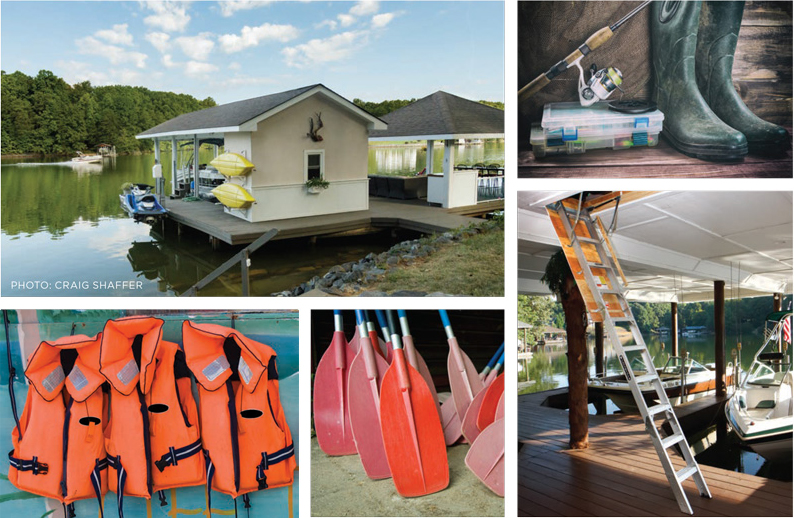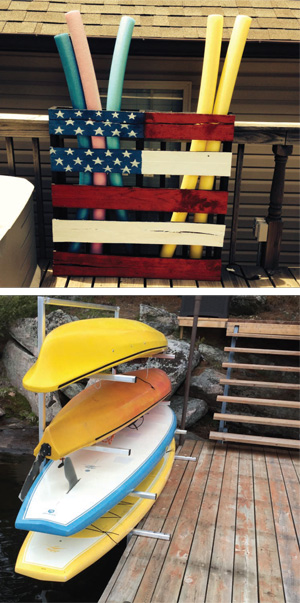
Summer is clearly the peak time at the lake, but our location on the map also affords us a lengthy season to play in the water or on the golf course. It gets warm early in the spring, and the sunshine and high temps can stretch into harvest season. It’s the kind of thing that leaves the folks at places such as Lake Michigan or Lake George or Lake Winnipesaukee feeling envious of our jewel.
The long recreation season also means that there’s ample opportunity to try out new toys on the water—which then leads to those toys starting to accumulate. Storage becomes an issue. You can’t very well leave your stand up paddleboard sitting on the dock all winter, where a powerful snowstorm can snatch it from you or where the sun’s rays can fade or warp it. Nor can you leave your fishing tackle sitting out on the table where the grandkids will mess with it during the holidays (You get a pass if your gear is sitting out because you’re making your own flies—we can all get behind that.) There needs to be appealing, practical and out-of-the-way places to keep your lake gear, to prevent clutter from taking over your residence or boathouse. If you take a moment to look high and low, near and far, you should be able to find the right place for everything, especially when the off-season rolls around.
 Benefitting at the boathouse
Benefitting at the boathouse
If you haven’t already enclosed the area above your boat slip, then make this a priority when seeking out more storage. Everyone’s dock is styled differently, but most can use the exposed rafters to create a ceiling with storage, which can be ample depending on the pitch of the roof. Floor racks can be installed so that paddleboards and similar equipment can be stored on their sides for protection and to take up minimal real estate. Think carefully before choosing to store kayaks in this location, however, as their hulls are susceptible to extreme heat and freezing temperatures (consult your dealer about storage recommendations).
Your new boathouse attic gets bonus points if a pull-down stairway is installed—that way inflatables and life vests are easily accessible at the waterfront, while the space is truly out of sight and mind when not needed.
The attic solution offers fringe benefits as well, such as the opportunity to install more elegant lighting and ceiling fans, while keeping the wiring hidden in the new attic space, and there’s no chance of birds roosting above your boat and leaving you “presents” that you have to clean off.
Shed the clutter
Many properties at the lake are on steep slopes, are heavily landscaped or don’t allow much room between neighbors. But if there’s a 12-by-12-foot space that can be leveled for shed installation, this might be your ticket to keeping the cumbersome stuff out of the main house.
While there are perfectly nice prefab sheds available on the market, it’s also possible to have them custom-made to coordinate with your home (and not break the bank). Sheds are all about maximizing storage opportunities, which means multiple layers of shelving, an array of hooks, pegboards and cabinetry will be vital to keeping your tackle organized, your tools off the ground and your wetsuit hung up. You can even get creative if you have exposed studs in the shed, adding shelves between them or using thin retaining boards to turn them into pockets for fishing poles or oars.
Free-standing containers
If you immediately jump to the idea that you’re limited to drab gray plastic when talking about deck storage containers, it’s time to do a little research. These days, they’re available in a variety of exteriors, such as light and dark woods, wicker and mock stone. Some of them have a bench-back and armrests or have space for cushions, allowing you to double-down on your need for storage and seating, especially during the summer months. These containers are typically waterproof, so they can be used for towels, water sports items, and inflatables, without worrying about opening up a musty mess weekend to weekend.
Using ‘dead space’ effectively
With many lake homes having at least two stories, it would be a waste not to use the space under the staircase to stash the gear. This is where cubbies (or cubed shelving) and hooks could do wonders to organize your smaller items, while also creating individualized nooks that grandchildren could each call their own. But don’t stop at storage below the staircase. Be creative. These kinds of features, along with more traditional shelving, can be added to unfinished space you may have in the basement. There are more than a few homes that have breakfast nooks off of the kitchen that incorporate seating with storage inside of them. These built-in benches can be quite long (as much as six feet) and can fit items such as life jackets for the littlest youngsters to put on before heading down to the water’s edge.
Snazzing up the garage
From hooks to nets to ceiling-mounted drop-shelving, there are dozens of ways to get your gear off the ground and out of the way in the garage when the time comes. To be able to allow for larger items, such as kayaks, boards, oars and coolers, installing overhead storage platforms are the way to go. Metal shelving can not only provide out-of-the-way storage but also offer numerous attachment points to hang clothing (like a wetsuit that needs to dry), bikes, golf clubs and mesh bags with water toys. Pick your placement properly, and you’ll still be able to pull your car all the way up to the wall.
Take your stuff off-site
If the off-season arrives, and you simply have too much stuff to store comfortably in your house or at the dock, self-storage facilities are also a popular option. If you only need to get to your things from time to time, there are more than half a dozen selfstorage sites located around Smith Mountain Lake. Remember, though, that while proximity is important, security should be the priority. Many of these facilities are gated, and being well-lit and equipped with plenty of cameras is a plus.
Storage options can—and should—be tailored to each individual’s home, and for custom houses, storage solutions should be factored into the design. We’re all familiar with the phrase, “Out of sight, out of mind.” Yet when it comes to lake living, we may want our water toys, safety equipment and recreational items out of the way, but we certainly don’t want them (or the lake) out of mind—at least not for long!
